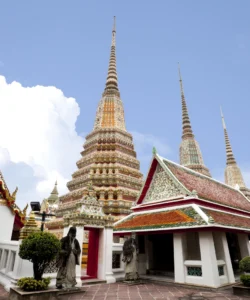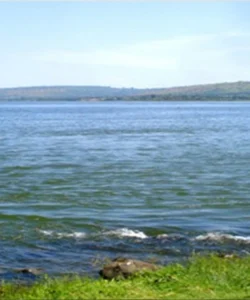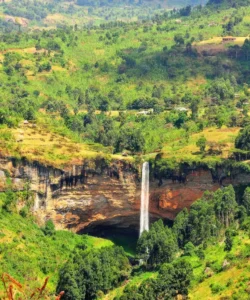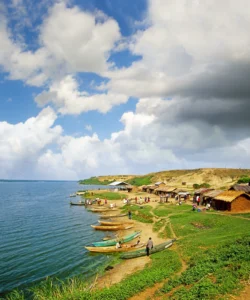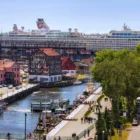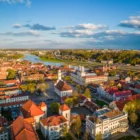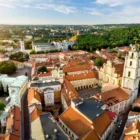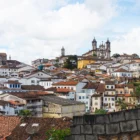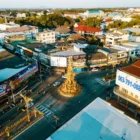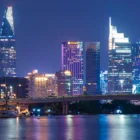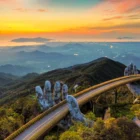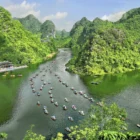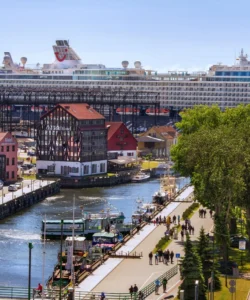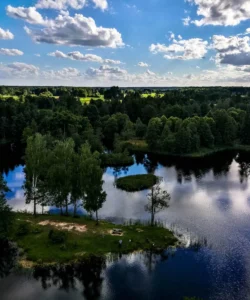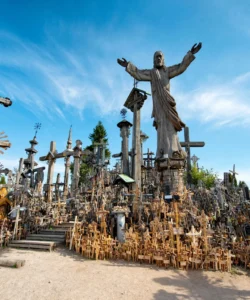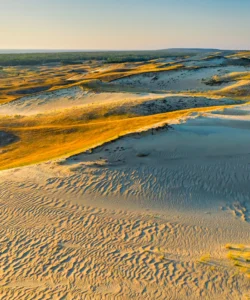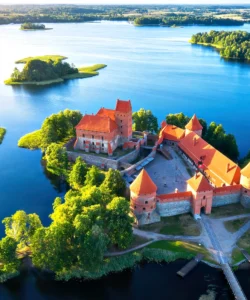Rwenzori Mountains National Park, located in southwestern Uganda along the border with the Democratic Republic of Congo, is a majestic and enigmatic mountain range often referred to as the “Mountains of the Moon.” Unlike other high African mountains that are volcanic, the Rwenzoris are a non-volcanic, uplifted block of crystalline rocks, making them geologically unique. A UNESCO World Heritage site and a Ramsar site, the park is renowned for its snow-capped peaks (despite being on the equator), its unique and bizarre afro-alpine flora, glaciers, numerous waterfalls, and challenging multi-day treks through distinct vegetation zones. It offers a profoundly different and often otherworldly mountaineering experience.
Name: Rwenzori Mountains National Park (also historically associated with “Mountains of the Moon”)
Address: Kasese District, Southwestern Uganda. The main trailheads are Nyakalengija (for the Central Circuit) and Kilembe (for the Kilembe Trail), both near Kasese town.
How to get there:
Reaching Rwenzori Mountains National Park, involves a significant international journey followed by domestic travel within Uganda:
- From Entebbe/Kampala (Uganda) to Rwenzori Mountains National Park:
- By Road (Common for Treks): The park is approximately 300-350 km (186-217 miles) west of Kampala. The drive takes around 4-8 hours, depending on the route (Kampala via Fort Portal to Kasese is generally shorter and faster; via Mbarara to Kasese is longer but passes through other national parks like Lake Mburo and Queen Elizabeth). A sturdy 4×4 safari vehicle is essential.
- By Air (Faster Option): Chartered flights can be arranged from Entebbe International Airport or Kajjansi Airfield (near Kampala) to Kasese Airstrip. The flight takes approximately 1.5-2 hours. From Kasese Airstrip, it’s a short drive (around 40 minutes) to the main trailheads like Nyakalengija or Kilembe.
Best Time to Visit:
The best times to visit/climb/hike/trek Rwenzori Mountains National Park are the drier seasons: June to August and December to February. During these months, the trails are less muddy, and there’s a higher chance of clear skies for summit views. However, rain can occur at any time in a tropical rainforest, so prepare for all weather conditions. The wetter seasons (March-May and September-November) see heavier rains, muddy trails, and more mist, but also fewer tourists and lush vegetation.
Operating Hours and Entrance Fee:
- Operating Hours: The park is generally open daily. Treks typically begin early in the morning.
- Entrance Fee (for Foreign Non-Residents):
- Park Entry Fee: US$35 per person per day.
- Mountaineering Permits: Separate fees apply for actual mountaineering permits, guides, porters, and accommodation in huts along the trekking routes (e.g., huts on the Central Circuit or Kilembe Trail). These costs are typically included in multi-day trekking packages offered by licensed operators.
- Note: Fees are subject to change by the Uganda Wildlife Authority (UWA). It’s crucial to book multi-day treks well in advance through a reputable tour operator, as permits and logistics require significant planning.
Landscape and Architecture:
The Rwenzori Mountains National Park’s “architecture” is its awe-inspiring natural landscape, shaped by geological uplift and unique climate conditions:
- Snow-Capped Equatorial Peaks: The defining feature. Despite being just kilometers from the equator, the higher elevations of the Rwenzori Mountains are permanently covered in snowfields and glaciers. This creates a surreal landscape of ice and rock against a tropical backdrop.
- Six Massifs: The range consists of six major massifs separated by deep gorges: Mount Stanley (home to Margherita Peak, Africa’s 3rd highest at 5,109m), Mount Speke, Mount Baker, Mount Emin, Mount Gessi, and Mount Luigi di Savoia.
- Glacial Lakes and Waterfalls: Numerous pristine glacial lakes shimmer amidst the high alpine zone, fed by meltwater. Fast-flowing rivers cascade down the mountainsides, forming magnificent waterfalls.
- Stratified Vegetation Zones (5 Distinct Zones): The park boasts an extraordinary diversity of ecosystems that change dramatically with altitude:
- Grassland (1,000-2,000m): At the lowest elevations, merging with agricultural land.
- Montane Forest (2,000-3,000m): Dense evergreen forest.
- Bamboo Zone (2,500-3,500m): Characterized by towering bamboo thickets, creating an eerie, dark environment.
- Heather Zone (3,000-4,000m): Dominated by giant heathers draped in moss, creating a “moss-draped wonderland.”
- Afro-Alpine Moorland Zone (4,000-4,500m): The most surreal and famous zone, home to the unique “botanical big game.”
- Nival Zone (above 4,500m): The realm of rock, snow, and glaciers.
- Unique Afro-Alpine Flora: This zone (above 4,000m) is what truly sets the Rwenzoris apart. It features bizarre and oversized plant species that have evolved in isolation, such as giant lobelias (Lobelia gibberoa, up to 10m tall), giant groundsels (Dendrosenecio adnivalis), and giant heather (Erica arborea). These “botanical giants” create an otherworldly, prehistoric-looking landscape often shrouded in mist.
- Rugged Peaks and V-shaped Valleys: The mountains are extremely rugged, with jagged ridges and deep, V-shaped glacial valleys.
- Trekking Huts/Camps: For trekkers, there are simple but essential overnight huts and camps (e.g., Nyabitaba, Bujuku, Kitandara Camps on the Central Circuit; Kalalama, Sine Hut on the Kilembe Trail), providing basic shelter. These are the only significant human-made “architecture” within the higher mountain environment.
What makes it famous:
Rwenzori Mountains National Park is famous for:
- “Mountains of the Moon” Legend: Its historical association with Ptolemy’s ancient description of the source of the Nile, known as the “Mountains of the Moon,” adds a mystical allure.
- Snow-Capped Equatorial Peaks: It’s one of the very few places on Earth near the equator to have permanent snow and glaciers, a truly unique climatic and visual phenomenon.
- UNESCO World Heritage Site: Recognized for its exceptional natural beauty, unique alpine flora, and important ecological processes.
- Unique Afro-Alpine Flora (“Botanical Big Game”): The bizarre and giant plant species found in its higher altitudes are unparalleled and make it a botanist’s dream and a photographer’s delight.
- Non-Volcanic Origin: Unlike other major African peaks (Kilimanjaro, Mount Kenya), the Rwenzoris were formed by geological uplift, giving them a distinct geological history and structure.
- Challenging Mountaineering and Trekking: It offers a challenging multi-day trekking and mountaineering experience, considered more technical and demanding than Kilimanjaro by some, providing a true adventure for experienced hikers. Margherita Peak is Africa’s third highest.
- Source of the Nile: The mountains are a vital water catchment, contributing to the source of the Nile River.
- Exceptional Biodiversity: Home to unique and endemic species of flora and fauna, adapted to its diverse altitudinal zones.
Differences from some other wonders:
Rwenzori Mountains National Park distinguishes itself from other famous mountains and natural wonders in several profound ways:
- Non-Volcanic Glaciated Equatorial Mountains: This is its most significant differentiator. While Kilimanjaro and Mount Kenya are also glaciated equatorial mountains, they are volcanic. The Rwenzoris are a non-volcanic block mountain range, uplifted and heavily glaciated, making their geological formation and resulting landscape unique globally.
- “Botanical Big Game” Flora: The sheer size and bizarre appearance of its afro-alpine flora (giant lobelias, groundsels, heathers) found at high altitudes, and nowhere else on Earth, create a surreal, almost prehistoric landscape that is utterly distinct from the vegetation on other high African mountains or temperate alpine regions.
- Multi-Day Trekking Through Distinct Zones: The trekking experience is a journey through five incredibly distinct vegetation zones (grassland, forest, bamboo, heather, afro-alpine, nival) over multiple days, offering a continuously evolving and diverse scenic progression that is highly unique.
- More Challenging and Less Commercialized Trekking: Compared to the more established and often crowded trekking routes on Kilimanjaro or Mount Kenya, Rwenzori offers a more rugged, challenging, and less commercialized mountaineering experience, appealing to serious trekkers seeking a wilder adventure.
- Consistent Wet and Misty Climate: Its close proximity to the equator combined with high altitude results in a nearly constant, misty, and wet climate. While this makes trekking more challenging, it also contributes to the unique lushness and atmospheric quality of its forests and the growth of its distinctive flora, distinguishing it from drier mountain environments.
- World Heritage Site for Nature, Not Culture: Its UNESCO status is specifically for its outstanding natural beauty and biodiversity, particularly its geology and unique flora, rather than being linked to human cultural landscapes or specific archaeological sites.
In essence, Rwenzori Mountains National Park is an extraordinary and mystical wonder, a profoundly unique high-altitude wilderness where snow and glaciers meet equatorial flora, offering a challenging yet unparalleled journey into one of Africa’s most beautiful and biologically significant mountain ranges.




















